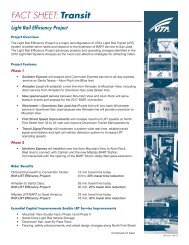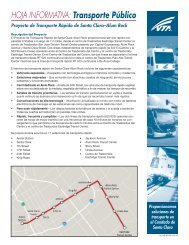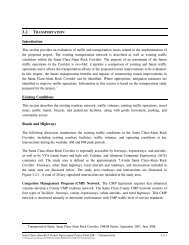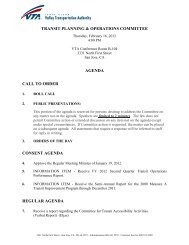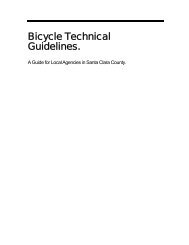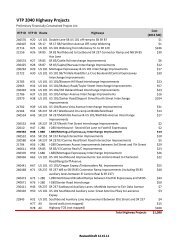Appendix I - Hazardous Materials Documentation - VTA
Appendix I - Hazardous Materials Documentation - VTA
Appendix I - Hazardous Materials Documentation - VTA
You also want an ePaper? Increase the reach of your titles
YUMPU automatically turns print PDFs into web optimized ePapers that Google loves.
4.1.1.2 Hot Spot Characterization<br />
Contaminant Management Plan, SVRT/BART Extension<br />
The preliminary reconnaissance characterization may identify certain samples with unexpectedly high<br />
contaminant concentrations. The unexpectedly high concentration samples may indicate an area represented<br />
by either a single sample or a relatively small number of samples. When these concentrations threaten to<br />
adversely affect the final design and/or construction, these results will be considered a potential indicator of a<br />
“hot spot”. In such circumstances, additional sampling and analysis will be performed to further characterize<br />
the hot spot.<br />
The approach to additional sampling and analysis will be dependent on the specific concentrations and<br />
relative locations of the unexpectedly high concentration samples. “Step-out” sampling will continue until the<br />
extent is defined to the limits of proposed construction. Hot spot characterization may be performed during<br />
either the final engineering design or the construction phases of the project.<br />
Once the vertical and horizontal extent of the hot spot is defined, this material will be removed during the<br />
construction phase. Hot spot material will be managed in accordance with the guidance provided herein,<br />
though handled separately from the surrounding excavated soils or ballast.<br />
4.1.1.3 Discovery of Unknown Impact<br />
Care will be taken during construction activities to note any stained, discolored, or odorous soils. If such soils<br />
are encountered, work will be stopped and the environmental engineer or geologist will be consulted. In the<br />
case of discolored soils, if the engineer or geologist decides that there is significant cause, the soil will be<br />
sampled for TPH-d (or any other suspected contaminant). In the case of strong odors or visual indications, the<br />
soil will be sampled for TPH-g, TPH-d, volatile organic compounds (VOCs), and/or SVOCs. No further work<br />
will be conducted with the impacted soil until analytical results have been received and reviewed, and either<br />
the soil has been found not to contain hazardous substances or engineering controls have been implemented to<br />
protect worker health and safety. During characterization, site control measures will be implemented to<br />
minimize exposure to potential hazardous substances.<br />
4.1.1.4 Waste Disposal Characterization<br />
Soil and ballast that contain chemical constituents at levels that are above the corresponding reuse<br />
concentrations (see Section 4.2) will be properly disposed off-site. Other material may also be disposed offsite<br />
at <strong>VTA</strong>’s discretion, such as soil that is not appropriate for reuse due to geotechnical or other<br />
characteristics, or excess material. As part of this process, all material to be disposed off-site will be<br />
characterized for final disposition while still on-site.<br />
101248 – July 2008 Page 28



